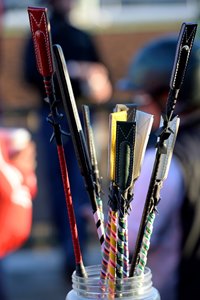CHRB Approves Further Riding Crop Restrictions


At a regular meeting Dec. 12 at Los Alamitos Race Course, the California Horse Racing Board advanced new riding crop rules its chairman called the most restrictive in United States racing.
The approved rule, which is now available for 45 days of public comment, will limit the number of times a jockey can strike a horse during a race to six. Riders will be allowed just two strikes in succession, requiring a pause to allow reaction from the horse before any further action.
Currently, California racing regulations allow for three strikes in succession before a response from the horse, with no maximum number of strikes during a race.
Jockeys' Guild president and CEO Terry Meyocks expressed concern that individual jurisdictions might create their own rules, leading to a problematic lack of uniformity. He noted New Jersey is working on a rule that he said would only allow the riding crop to be used for rider safety purposes and that the Association of Racing Commissioners International and the track-led Thoroughbred Safety Coalition are working on versions of rules.
Thoroughbred Owners of California president and CEO Greg Avioli agreed with the Guild and encouraged the board to delay action for the sake of uniformity, until it saw other rules being considered.
"I think this rule is important enough that I'm not sure any immediate action is going to outweigh waiting and getting it right," Avioli said. "The TOC supports the Jockeys' Guild in that they are the ones who have the most at stake in this."
The rule could be tweaked after the public comment period.
"We just passed the most restrictive whip rule in North America," said CHRB chairman Greg Ferraro, adding the regulator couldn't afford further delay. "We got to the point that we had to move. Somebody has to be first."
The board did change the wording of sanctions recommended in the initial proposal outlined Thursday. Originally, the rule called for a minimum fine of $1,000 and a three-day suspension. After board member Alex Solis, a retired Hall of Fame rider, and jockeys in attendance pointed out that a $1,000 fine would be more punitive for riders at tracks with smaller purses, the rule was changed to call for "up to a $1,000 fine," leaving the three-day suspension in place.
The wording also notes that showing a horse the whip does not count toward the six-strike maximum.
Jockeys' Guild staff were frustrated they were not included in crafting the new rule, which Ferraro said was the third proposal considered in the past few months. Board member Wendy Mitchell, who voted for the new rule, agreed that riders should have been included in the discussions, adding they should be consulted on such changes going forward.
Noting that riders already have adjusted to many recent rule changes, and changes to the riding crop itself, jockey Aaron Gryder said the public has to be educated about the use of the riding crop in the sport.
"The riding crop is not a weapon. It's a tool—a tool to get a horse's attention," Gryder said. "It's not there to hurt a horse. It's about attention."
Meyocks emphasized that point as well.
"We worked with the industry to change the riding crop. Horses are not getting cut up or welts," Meyocks said. "If anyone abuses a horse, they should be punished. The riding crop today is a tool used to protect the horse and the rider."
Craig Fravel, CEO of racing operations for The Stronach Group, which in California owns Santa Anita Park and Golden Gate Fields, said he preferred a more restrictive rule that limits riders to using the riding crop only for safety reasons and not encouragement. In a comment suggesting riders primarily want riding crops as a means to encourage horses, rather than for safety reasons, he said he observes jockeys controlling their horses without use of riding crops during the early stages of the race.
Among other CHRB actions Thursday, the California Thoroughbred Trainers have not reached an agreement with Santa Anita ahead of the 2019-20 winter/spring meeting. The hang-up is the track's proposed policy on barring trainers.
The CTT said protections for trainers in a previous agreement are being eliminated by The Stronach Group. After the track owner banned Jerry Hollendorfer from its tracks this year, the CTT joined the Hall of Fame trainer in legal actions over the issue.
In an effort to reach an agreement on the issue, the CHRB appointed its own vice chairman, Oscar Gonzales, to oversee a meeting between the two sides ahead of the meet's scheduled opening date of Dec. 26.
The board also approved requiring pertinent medical information from a horse claimed in a race to be transferred from the horse's former attending veterinarian to the new attending vet. And the regulator adopted a prohibition on the administration of bisphosphonates to any horse at a CHRB-regulated property.
